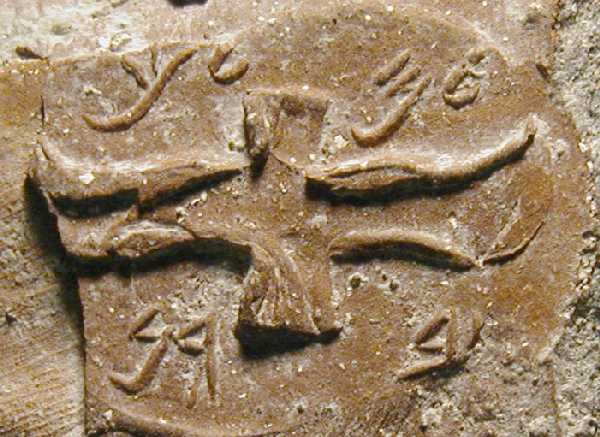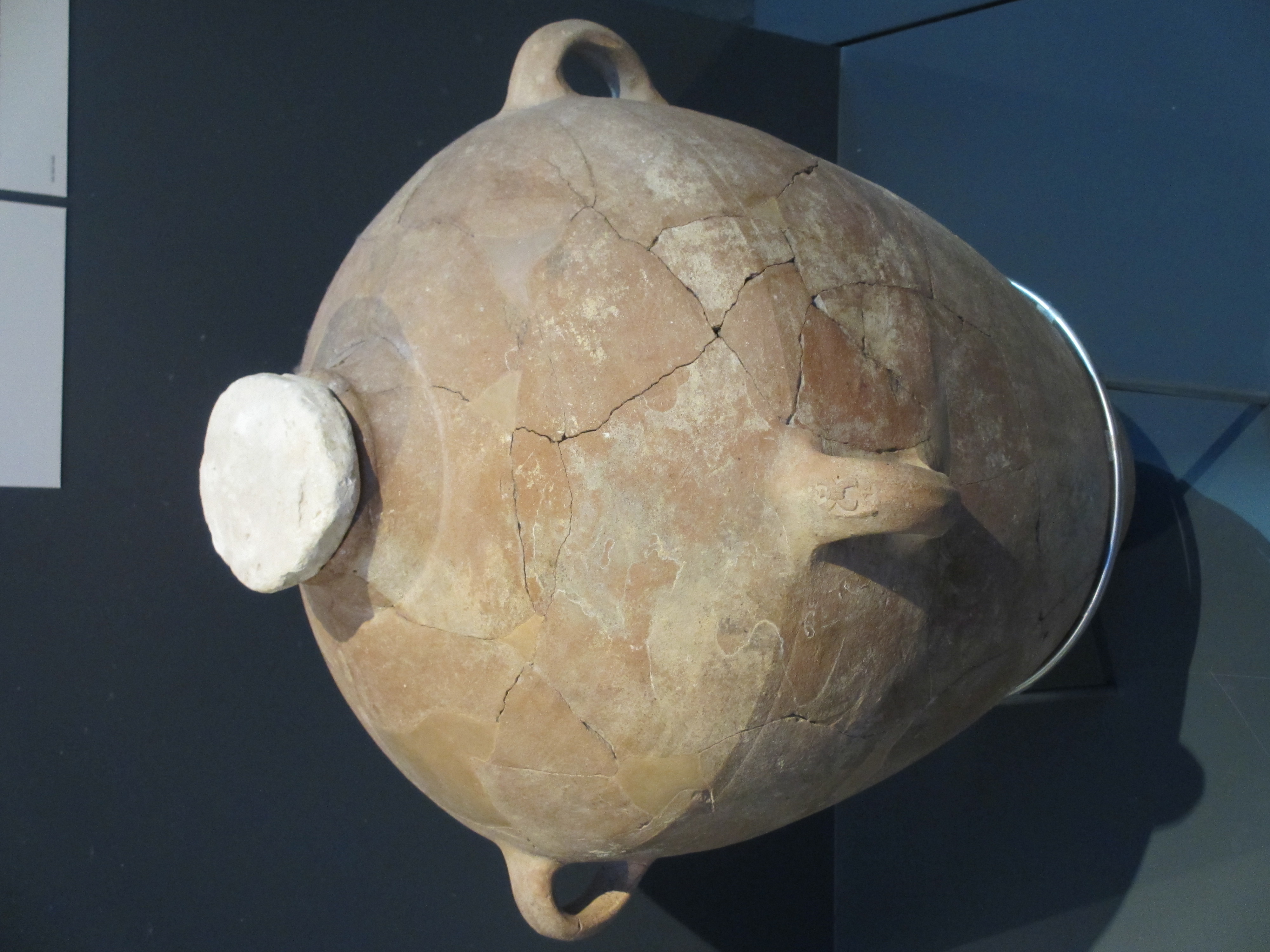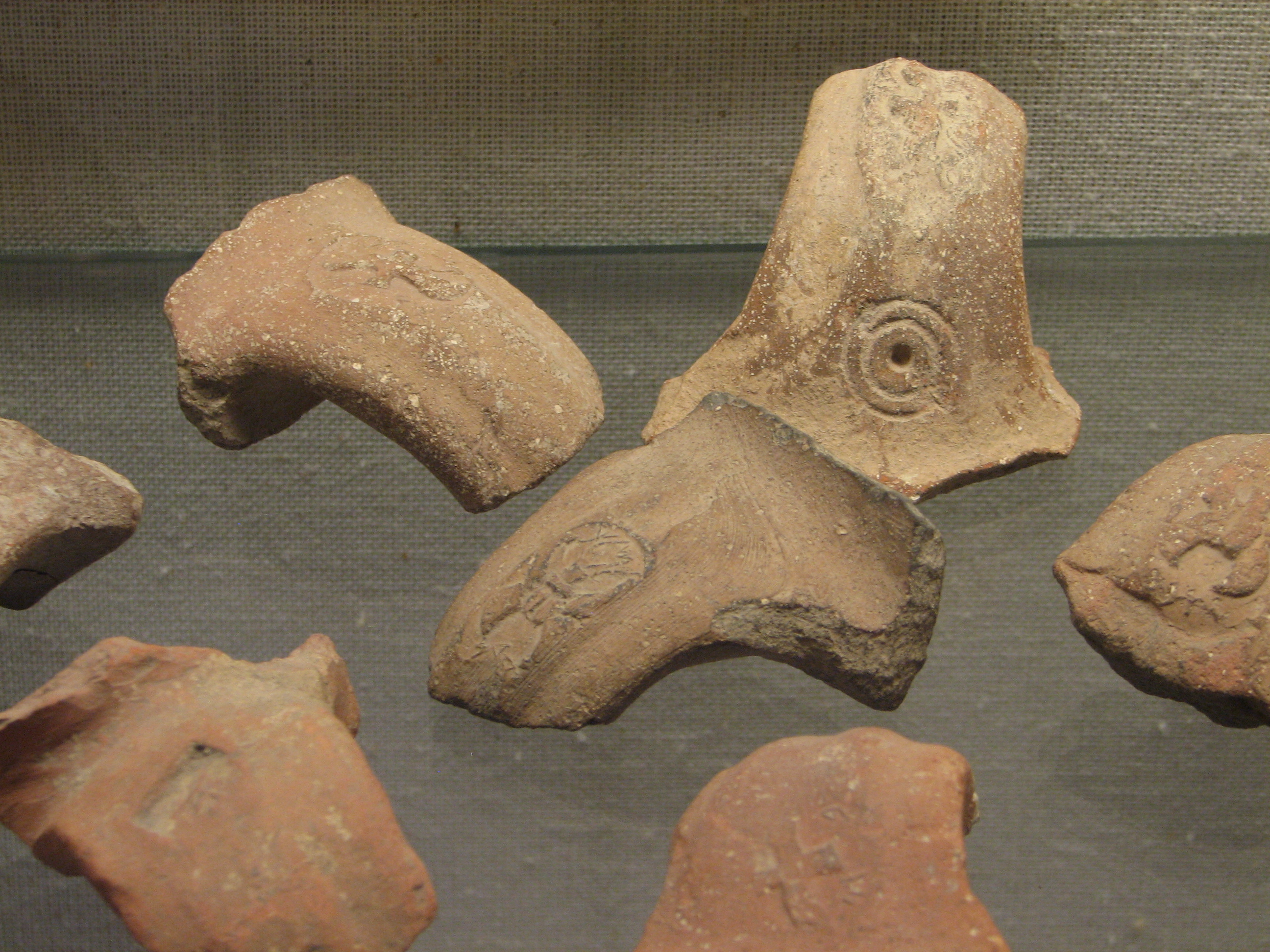LMLK seal on:
[Wikipedia]
[Google]
[Amazon]
LMLK seals (with LMLK meaning 'of the king') are ancient
 LMLK stands for the Hebrew letters '' lamedh
LMLK stands for the Hebrew letters '' lamedh
 Though most of these stamped jar handles have been found in the southern kingdom (71 sites in the ancient territory assigned to the tribes of Judah, Benjamin, and Simeon), some have also been found in the northern kingdom (four sites in the northwest region). Over 2,000 stamped jar handles have been found. The 20 sites where the most specimens have been found are:
* Khirbet Qeiyafa: 693
* Lachish: 415
*
Though most of these stamped jar handles have been found in the southern kingdom (71 sites in the ancient territory assigned to the tribes of Judah, Benjamin, and Simeon), some have also been found in the northern kingdom (four sites in the northwest region). Over 2,000 stamped jar handles have been found. The 20 sites where the most specimens have been found are:
* Khirbet Qeiyafa: 693
* Lachish: 415
*
 Beginning with the ''
Beginning with the ''


 Several hundred seal impressions made on the same type of jar handle have been found in the same contexts as the LMLK stamps. Over 50 types have been documented, and most of them have a 2-line inscription divided by two somewhat parallel lines. Some have an icon in addition to the inscription; others are strictly anepigraphic (Vaughn 1999).
Several hundred seal impressions made on the same type of jar handle have been found in the same contexts as the LMLK stamps. Over 50 types have been documented, and most of them have a 2-line inscription divided by two somewhat parallel lines. Some have an icon in addition to the inscription; others are strictly anepigraphic (Vaughn 1999).
Hebrew
Hebrew (; ; ) is a Northwest Semitic language of the Afroasiatic language family. Historically, it is one of the spoken languages of the Israelites and their longest-surviving descendants, the Jews and Samaritans. It was largely preserved ...
seals
Seals may refer to:
* Pinniped, a diverse group of semi-aquatic marine mammals, many of which are commonly called seals, particularly:
** Earless seal, or "true seal"
** Fur seal
* Seal (emblem), a device to impress an emblem, used as a means of a ...
stamped on the handles of large storage jars first issued in the reign of King Hezekiah (circa 700 BC) and discovered mostly in and around Jerusalem
Jerusalem (; he, יְרוּשָׁלַיִם ; ar, القُدس ) (combining the Biblical and common usage Arabic names); grc, Ἱερουσαλήμ/Ἰεροσόλυμα, Hierousalḗm/Hierosóluma; hy, Երուսաղեմ, Erusałēm. i ...
. Several complete jars were found '' in situ'' buried under a destruction layer
A destruction layer is a stratum found in the excavation of an archaeological site showing evidence of the hiding and burial of valuables, the presence of widespread fire, mass murder, unburied corpses, loose weapons in public places, or other evid ...
caused by Sennacherib at Lachish. While none of the original seals have been found, some 2,000 impressions made by at least 21 seal types have been published. The iconography of the two and four winged symbols are representative of royal symbols whose meaning "was tailored in each kingdom to the local religion and ideology".
Text
 LMLK stands for the Hebrew letters '' lamedh
LMLK stands for the Hebrew letters '' lamedh mem
Mem (also spelled Meem, Meme, or Mim) is the thirteenth letter of the Semitic abjads, including Hebrew mēm , Aramaic Mem , Syriac mīm ܡ, Arabic mīm and Phoenician mēm . Its sound value is .
The Phoenician letter gave rise to the Greek ...
lamedh kaph
Kaph (also spelled kaf) is the eleventh letter of the Semitic abjads, including Phoenician kāp , Hebrew kāf , Aramaic kāp , Syriac kāp̄ , and Arabic kāf (in abjadi order).
The Phoenician letter gave rise to the Greek kappa (Κ), ...
'' (vocalized, ''lamelekh''; Phoenician ''lāmed mēm lāmed kāp'' — 𐤋𐤌𐤋𐤊), which can be translated as:
* " elongingto the king" (of Judah)
* " elongingto King" (name of a person or deity)
* " elongingto the government" (of Judah)
* "o be sent
O, or o, is the fifteenth letter and the fourth vowel letter in the Latin alphabet, used in the modern English alphabet, the alphabets of other western European languages and others worldwide. Its name in English is ''o'' (pronounced ), plu ...
to the King"
As a prepositional prefix, the lāmed (𐤋) has either a genitive or dative function, and the "to" in each of the above readings can also be read as "for" or "of". The other three letters form the word "melech"; as shown above, its translation can refer to a specific king, to any king, or to the king's government.
A number of jars say "lmlk Ziph", "lmlk Hebron", "lmlk Socoh" and "lmlk mmst" (mmst being a town in the northern hill country). These jars were all manufactured in a single site in the Shfela, possibly Lachish, under the authority of the king (alluded to in 1 Chronicles 4:23, thus 'lmlk' means 'belonging to the king'), and from there they were sent to each one of the four administrative region indicated by either the name of the town on the jar (these being Ziph, Hebron
Hebron ( ar, الخليل or ; he, חֶבְרוֹן ) is a Palestinian. city in the southern West Bank, south of Jerusalem. Nestled in the Judaean Mountains, it lies above sea level. The second-largest city in the West Bank (after Eas ...
, Socoh and MMST).
Sites and quantities
 Though most of these stamped jar handles have been found in the southern kingdom (71 sites in the ancient territory assigned to the tribes of Judah, Benjamin, and Simeon), some have also been found in the northern kingdom (four sites in the northwest region). Over 2,000 stamped jar handles have been found. The 20 sites where the most specimens have been found are:
* Khirbet Qeiyafa: 693
* Lachish: 415
*
Though most of these stamped jar handles have been found in the southern kingdom (71 sites in the ancient territory assigned to the tribes of Judah, Benjamin, and Simeon), some have also been found in the northern kingdom (four sites in the northwest region). Over 2,000 stamped jar handles have been found. The 20 sites where the most specimens have been found are:
* Khirbet Qeiyafa: 693
* Lachish: 415
*Jerusalem
Jerusalem (; he, יְרוּשָׁלַיִם ; ar, القُدس ) (combining the Biblical and common usage Arabic names); grc, Ἱερουσαλήμ/Ἰεροσόλυμα, Hierousalḗm/Hierosóluma; hy, Երուսաղեմ, Erusałēm. i ...
: 281
*Ramat Rahel
Ramat Rachel or Ramat Raḥel ( he, רָמַת רָחֵל, ''lit.'' Rachel's Heights) is a kibbutz located in central Israel. An enclave within Jerusalem's municipal boundaries and overlooking Bethlehem and Rachel's Tomb (for which the kibbutz i ...
: 163
* Gibeon: 92
* Mizpah: 88
*Beth Shemesh Beth Shemesh (''House of the Sun'') is the name of three distinct biblical places in Israel and one location in Egypt also mentioned in the Hebrew Bible:
*a city in southwest Judah, remains excavated next to modern Beit Shemesh
*a city in north ...
: 71
*Moresheth-Gath
Moresheth-Gath ( he, מוֹרֶשֶׁת גַּת), also Moreshet-Gat, was a town of the tribe of Judah in ancient Israel mentioned in the Bible. It was located in the Shephelah region between Lachish and Achzib.
Etymology
The name ''Moresheth-Ga ...
: 39
* Gezer: 37
*Khirbet el-Burj
The glossary of Arabic toponyms gives translations of Arabic terms commonly found as components in Arabic toponyms. A significant number of them were put together during the PEF Survey of Palestine carried out in the second half of the 19th cen ...
(northwest suburb of modern Jerusalem): 24
*Maresha
Tel Maresha ( he, תל מראשה) is the tell (archaeological mound) of the biblical Iron Age city of Maresha, and of the subsequent, post-586 BCE Idumean city known by its Hellenised name Marisa, Arabised as Marissa (ماريسا). The tell i ...
h: 19
* Azekah: 18
* Timnah: 15
* Gibeah: 14
* Tel Erani: 13
*Hebron
Hebron ( ar, الخليل or ; he, חֶבְרוֹן ) is a Palestinian. city in the southern West Bank, south of Jerusalem. Nestled in the Judaean Mountains, it lies above sea level. The second-largest city in the West Bank (after Eas ...
: 13
* Sokho (Khirbet Abbad NW of Hebron, not the Sokoh SW of Hebron): 13
* Beth Zur: 11
* Arad: 9
* Nahal Tut: 8
* Gath (city): 6
Theories
editio princeps In classical scholarship, the ''editio princeps'' (plural: ''editiones principes'') of a work is the first printed edition of the work, that previously had existed only in manuscripts, which could be circulated only after being copied by hand.
For ...
'' by Charles Warren in 1870, a diverse assortment of theories has been promulgated to explain their function. Since the landmark excavations at Lachish by David Ussishkin during the 1970s, which established the date of the seals to the reign of Hezekiah, the number of feasible explanations has narrowed down to these (all associated with Hezekiah.
* Military rations collected as an emergency during a short period (several months to a few years at most) preceding the Assyria
Assyria ( Neo-Assyrian cuneiform: , romanized: ''māt Aššur''; syc, ܐܬܘܪ, ʾāthor) was a major ancient Mesopotamian civilization which existed as a city-state at times controlling regional territories in the indigenous lands of the A ...
n invasion by Sennacherib
* Government taxes collected throughout the majority of Hezekiah's reign (either 14 or 26 years depending on chronological interpretations) as a long-term economic buildup until the Assyria
Assyria ( Neo-Assyrian cuneiform: , romanized: ''māt Aššur''; syc, ܐܬܘܪ, ʾāthor) was a major ancient Mesopotamian civilization which existed as a city-state at times controlling regional territories in the indigenous lands of the A ...
n invasion by Sennacherib
* Religious tithes collected throughout Hezekiah's 29-year reign in response to his worship reformation following his accession (completely irrespective of the Assyria
Assyria ( Neo-Assyrian cuneiform: , romanized: ''māt Aššur''; syc, ܐܬܘܪ, ʾāthor) was a major ancient Mesopotamian civilization which existed as a city-state at times controlling regional territories in the indigenous lands of the A ...
n invasion by Sennacherib)
In support of the first two theories are the inscriptions, which can be read as the names of four places; in support of the third theory are the geographic statistics, which do not associate any of the four words to a particular place or region other than the entire southern kingdom of Judah. Furthermore, approximately 10–20 percent of the excavated jars and jar handles were stamped.
Depending on which of the above theories are preferred, several other aspects of the operation need interpretation:
* The people who performed the stamping were either government officials working directly for King Hezekiah or Levite
Levites (or Levi) (, he, ''Lǝvīyyīm'') are Jewish males who claim patrilineal descent from the Tribe of Levi. The Tribe of Levi descended from Levi, the third son of Jacob and Leah. The surname ''Halevi'', which consists of the Hebrew de ...
s and/or priests associated with Solomon
Solomon (; , ),, ; ar, سُلَيْمَان, ', , ; el, Σολομών, ; la, Salomon also called Jedidiah (Hebrew language, Hebrew: , Modern Hebrew, Modern: , Tiberian Hebrew, Tiberian: ''Yăḏīḏăyāh'', "beloved of Yahweh, Yah"), ...
's Temple in Jerusalem
The Temple in Jerusalem, or alternatively the Holy Temple (; , ), refers to the two now-destroyed religious structures that served as the central places of worship for Israelites and Jews on the modern-day Temple Mount in the Old City of Jeru ...
.
* The icons symbolize either royal stature or a religious nature (, , , , , , and ).
* The super-inscription, ''LMLK'', denotes the Judean government or a specific, divine being (consider its application to the Israelite YHWH as in , , and ).
* The sub-inscriptions (Hebron
Hebron ( ar, الخليل or ; he, חֶבְרוֹן ) is a Palestinian. city in the southern West Bank, south of Jerusalem. Nestled in the Judaean Mountains, it lies above sea level. The second-largest city in the West Bank (after Eas ...
, MMST, Socoh, and Ziph) record either 4 places or 4 votive statements.
Engraving styles indicate at least two, possibly five, people made the seals. The 21 types can be grouped together in five or six sets, but they may have been created or utilized in pairs based on quantities of their impressions found so far.
Researchers frequently use a lowercase "x" as a wildcard character when referring to a series such as x4C instead of using an uppercase "G", "H", "M", "S", or "Z" for the first letter designator. Likewise, an "x" can be used for the second letter designator when referring to all seals with the same word, such as H2x in lieu of H2D, H2T, and H2U.
Thus far, significant quantities of x4C, x4L, and x2U stamps have been excavated from below the destruction layer caused by the Assyria
Assyria ( Neo-Assyrian cuneiform: , romanized: ''māt Aššur''; syc, ܐܬܘܪ, ʾāthor) was a major ancient Mesopotamian civilization which existed as a city-state at times controlling regional territories in the indigenous lands of the A ...
n conquest of Sennacherib, but only a single specimen each of the G2T and M2D stamps (excavated from Jerusalem
Jerusalem (; he, יְרוּשָׁלַיִם ; ar, القُدس ) (combining the Biblical and common usage Arabic names); grc, Ἱερουσαλήμ/Ἰεροσόλυμα, Hierousalḗm/Hierosóluma; hy, Երուսաղեմ, Erusałēm. i ...
, which was not destroyed by Sennacherib). This suggests that 12 of the 21 seals were made prior to the attack, and the remaining 9 afterwards. The first significant evidence to support this datum came from the landmark excavations at Timnah led by George L. Kelm and Amihai Mazar.Mazar and Panitz-Cohen, ''Timnah (Tel Batash) II''.
Personal seals
Incisions
In addition to the seals, which were stamped in the wet clay before being fired in a kiln, certain other marks were incised on these jar handles: *Concentric circles (usually two—sometimes only one; sometimes applied to unstamped handles but it is uncertain whether they were ever incised on unstamped jars) *Plus marks (resembling "+" or "t" or "X") *Hole marks (resembling the central anchor dot of the concentric circles) *Drag marks (probably attempts to cancel or obliterate the LMLK stamp) Hundreds of the Circles have been found, but only a few of the Plus, Hole, and Drag marks. Several LMLK stamps may have had additional inscriptions incised over them containing marks resembling the letters "I V" (hence "''Ivy'' incisions"); however, one or more of these handles may just contain stray Drag marks resembling the letters "I V" with no literate semantics intended.Israeli postage
In 1948, Israel's postal authority chose the Z2U seal design for the first series ofpostage stamp
A postage stamp is a small piece of paper issued by a post office, postal administration, or other authorized vendors to customers who pay postage (the cost involved in moving, insuring, or registering mail), who then affix the stamp to the f ...
s to include the name of the renascent state. Five multicolored values (3, 5, 10, 20, and 65-mil denominations; Scott catalog numbers 10-4) were printed in sheets of 300 (six panes of 50). Otte Wallish designed the stamps, which have distinctive tabs written in Hebrew declaring: ''Flying Scroll: "LMLK" Seal Stamped on the Wine and Oil Jugs Given as Tax to the King''. Israel released the stamps on September 26, 1948 in time for the October 4 observance of Rosh Hashanah
Rosh HaShanah ( he, רֹאשׁ הַשָּׁנָה, , literally "head of the year") is the Jewish New Year. The biblical name for this holiday is Yom Teruah (, , lit. "day of shouting/blasting") It is the first of the Jewish High Holy Days (, , ...
5709, the Jewish New Year, and thereby inaugurated its annual series of holiday stamps.
Drawings
Types of LMLK seals:See also
* Archaeology of Israel * Biblical archaeology * List of artifacts significant to the Bible *Hebrew alphabet
The Hebrew alphabet ( he, אָלֶף־בֵּית עִבְרִי, ), known variously by scholars as the Ktav Ashuri, Jewish script, square script and block script, is an abjad script used in the writing of the Hebrew language and other Jewi ...
*Phoenician alphabet
The Phoenician alphabet is an alphabet (more specifically, an abjad) known in modern times from the Canaanite and Aramaic inscriptions found across the Mediterranean region. The name comes from the Phoenician civilization.
The Phoenician al ...
References
Bibliography
* * * * {{DEFAULTSORT:Lmlk Seal 8th-century BC inscriptions 8th century BC in the Kingdom of Judah Archaeological sites in Israel Seals (insignia) Cylinder and impression seals in archaeology Hezekiah